How Disney’s “Hell Fire” Illuminates the Struggle of the Subconscious
Walt Disney movies are known for their didactic quality and clear distinctions between good and evil. The audience never leaves a Disney movie wondering if the right character got their happily ever after. The uplifting nature associated with these films is strongly supported by their score and sound tracks. Who doesn’t remember Mrs. Potts singing the ballad “Tale as Old as Time” or dancing in our seats to “Under the Sea” from the Little Mermaid?
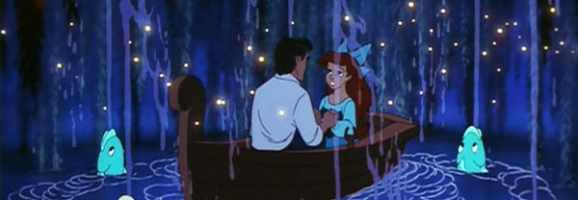
The odd duck out is Disney’s 1996 version of The Hunchback of Notre Dame. While the movie’s narrative retains a sense of darkness true to the original novel, there are those comedic touches giving it that Disney flair. The gothic overtones of the novel find their way into the film’s score, which despite a few overall flaws carries much of the thematic weight. It is speculated that the overwhelming sense of gloominess and somber tones found in the soundtrack are a primary reason for the movie’s overall failure at the box office. According to Marc Miller, from his chapter in “Film Genre 2000: New Critical Essays”, the music for the movie ranged from an intriguing mix of “comic numbers, characters songs, and ballads” (54). Of this musical mixture, the number “Hellfire” sung by Frollo has received the most notoriety.
As children, many of us failed to notice the sexual tension and religious iconography associated with the number and as adults, it is startling and shocking that the Mouse let this happen. Thankfully, it did happen because the result is a gorgeous and dark number that renders Frollo into a more complicated villain than Disney usually allows. This complication does not mean we struggle to dislike Frollo; in fact, his complexity invites us to dislike him for many reasons. His song is in part powerful because of the reaction it demands from its audience. The audience cannot perceive the song without simultaneously realizing that Frollo is more human than other Disney antagonists. The human quality of his suffering makes him utterly frightening. Although Freud and psychoanalysis are forced upon everything ranging from films to imagery found on grilled cheese, the psychologically complex nature of Frollo lends itself to this type of analysis. This article focuses specifically on how the musical number communicates the internal struggles Frollo faces earning him the title of Disney’s most frightening villain.
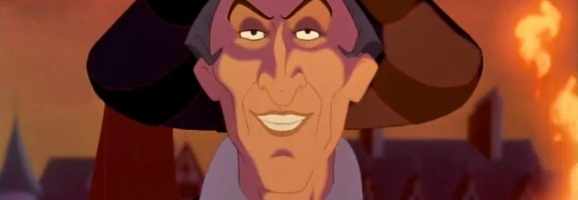
The song appears directly after the number “Heaven’s Light” sung by Quasimodo, in which he describes his love for the gypsy Esmeralda. “Hellfire” is a darker reprise of this earlier song. In the placement of these two songs against each other, Disney implies a system of good and evil. Disney cannot fully escape the need to clearly define this binary. The difference is that Disney’s villain’s songs are usually catchier and don’t focus on internal turmoil. Their evil is inherent to their character and they do not struggle with it. For example, Ursula and Hades both revel in their wickedness. Their hubris and joy in the causing pain provides us with a sense of safeness because we know in the end that they will lose. Virtue will triumph. These types of villains are not as scary because they are never treated seriously enough to become a threat. Yes, as a child some of these villains appear frightening, but none of them shake you to the core. Frollo is closer to a villain like Chernabog, from Fantasia, than his fellow talking villains. His mere presence rattles something deep in us. The songs of the more popular villains ensure that we do not take them as a serious threat to our thinking. Frollo’s song, while arranged beautifully, is not an easy melody to memorize or sing at Disney karaoke. The song breaks the mold that evil is just evil by illuminating the darkness of the subconscious.
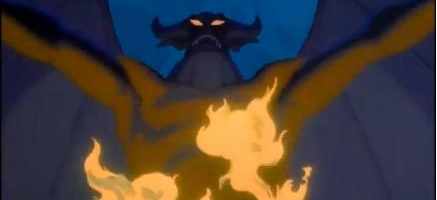
This musical arrangement helps identify why Frollo frightens us. Villains like Scar or the Queen of Hearts never fight against being the antagonist; whereas, Frollo struggles with himself. Frollo’s self-awareness becomes a primary reason for our discomfort. It reminds us of our own ability to degenerate into deviance. Disney’s usual light- heartedness serves as an escape and something safe. We know the structure of Disney films. We know what we expect. We do not watch Beauty and the Beast or Pinocchio thinking that the film is going to challenge our belief in “happily ever after”. This creates a system where we must also know villains are bad. Frollo confronts us with his struggle and to be confronted with it breaks the safety of the binary between good and evil. We are asked to understand a villain in a way we do not expect or anticipate from Disney.
The song begins with the monks chanting through the halls of Notre Dame. The chanting acts as a sound bridge to move the audience from Notre Dame to Frollo’s residence. The sound bridge is important because it attempts to distinguish Frollo from the Church. In the original novel, Frollo is an archdeacon but Disney higher-ups did not want him to remain a member of the Church in their film. However, the artists on the film understood the importance of Frollo’s association with the Church in understanding his psychological drives. The novel takes place in France before the Reformation and religion is a thematic focus. It becomes hard to have pre-reformation France without Catholicism. Within the Disney canon, this film was the first to use “God” and “Lord” so frequently throughout. Frollo’s appearance remained closely associated with Church garb and the use of Catholic prayers in his song reinforce the role of religion in his psyche. As audience members, any easy distinction between Church and political figures is blurred. We do not see Frollo as a political figure but as a highly religious man tormented by his beliefs. This is further explored in the mise-en-scene where a cross without the Christ figure hangs on the wall.
The chanting inside Notre Dame feels natural, but as it fades into the background of Frollo’s song it takes on a sinister quality. The mixing and blending of the two songs represents the blurring of religious boundaries inside Frollo’s mind. Although the soft chanting feels suffocated by Frollo’s deep bass tones, the tension created is empathetic to his internal struggle.
The chanting begins as monophonic meaning the monks follow one melodic line. The “Oh Maria” hymn that they sing is purely their voice and a representation of a purer form of Catholicism. The instrumentation that begins after the chanting is a mix of heavy string, bells, timpani, and strong bass cords. The “Oh Maria” hymns become homophonic as Frollo’s number begins. There is competition between the gentler version of the hymn and the strong organ sounds of Frollo’s version.
The thick texture reflects the discord of Frollo’s religious beliefs. The internal conflict forces him to confront his lust for Esmeralda. Just as the two hymns compete, so too does lust and religion. As the song progresses it becomes clearer that Frollo’s desire for Esmeralda is causing a deep sense of shame in him and hatred towards her. Within the dissonance we see the manifestation of Frollo’s Id, Ego, and Superego.
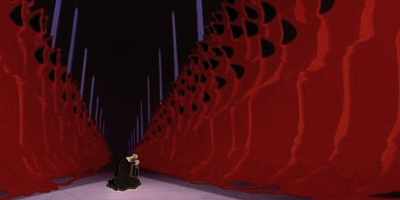
Let’s have a Threesome: Religion, Lust, and the Superego
The terms Id, Ego, and Superego are frequently used in relation to a wide variety of topics and disciplinary fields. Before we look at how the song reflects these, we must first be sure of what they are. All three of these ideas come from the larger works of Sigmund Freud. Although much of Freud’s work is debated or debunked, these three terms continue to inspire academic work and analysis. The Id is the chaotic part of us driven purely by instinct. The Ego is the middle child that struggles between the chaotic Id and the over-controlling Superego. The Ego wants to act according to the reality principal and helps guide us in our everyday actions. Like other middle children, the Ego must employ self-defense tactics to remain stable. The Superego is our internalization of cultural, societal, and religious ideals and wants nothing else but perfection. The Superego will use guilt and shame against the Ego in order to achieve this unattainable perfection.
We all have heard the jokes about Catholics being plagued by perpetual guilt. This stems from the Superego’s desire for religious perfections and the conflict of being a flawed human with an Id. To overcome the imperfections, we must acknowledge our sins and repent according to the religious doctrine. Catholic hymns reflect the need for acknowledgement but this honesty is halted by the Ego. The Ego wants to protect itself from shame that the Superego will inflict upon realizing failures. “Hellfire” employs this need for confession and acknowledgement to demonstrate Frollo’s inability to feel responsible for his actions. The song contains sections of the Confiteor (A Catholic Latin Prayer), which translates to “I confess” or “I acknowledge”.
There is an ironic use of the Confiteor hymn as Frollo sings “it’s not my fault,” while the large red hooded figures sing “my fault” repeatedly in Latin. Frollo’s lack of taking responsibility for his actions is a result of the Superego’s need for unobtainable perfection. To recognize his active lust for her would be to tarnish the Superego. The implementation of the omniscient hooded figures indicates the extent of Frollo’s religious interpellation. The Superego has created these omniscient figures to condemn him and force the Id to remain in the subconscious. The Ego attempts to hide the desire to refrain from this internal punishment. Frollo uses projection to place the blame on Esmeralda rather than confronting his own role.
The song also plays with the use of the Kyrie Elusion chant, which is uttered during lamp lighting ceremonies, but in this scene, the light is “hell fire”. Inside the fire, images of Esmeralda can be seen dancing as Frollo holds her scarf. Adults notice the fetishism that is attached to this image. As he clutches her scarf, his cries to Maria become fortissimo. It appears that the two female figures begin to merge into each other. Sounds of Esmeralda’s instrument can be heard coming from the fireplace. The Id’s lust merges with the Superego’s religious ideals of perfection so Maria, the virgin mother, becomes the same as Esmeralda. Blurring continues in the use of diegetic and non-diegetic sounds, which means we do mpy know if these sounds are heard in the film or only to us. This is a result of being unaware if these are internal sounds generated by Frollo’s mind or are we the only ones hearing them?
Religion becomes a tool to control the animalistic desires of the Id including his powerful sexual urges. Catholicism has helped Frollo’s Superego control the Id up until this breaking point. The Superego’s unrealistic desire for perfection causes Frollo to become alienated from himself, which creates a struggle for stability. The Ego must correct this instability by making the unacceptable desires appear acceptable. Unlike other villains, the song portrays the stakes and the urgency of Frollo’s predicament. Although Hades has a schedule, we never feel the urgency. Ursula could have continued to stay in her watery cave so there are not real stakes. The song brings to the forefront the internal stakes attached to Frollo’s conscious and subconscious motives. There is urgency in the song demonstrated through the music’s intense crescendoing as the flames grow larger. The softness of the opening to the intensity of the conclusion mirrors Frollo’s progression from lust to violence. The audience is invested in the song because it will reveal whether Frollo should be damned. The song becomes an important factor to the plot and the basic understanding of his character. By the end, the Ego has successfully mediated between the Id and the Superego by projecting the lust, shame, and guilt onto the gypsies. Frollo can now act violently towards them because they represent everything he hates inside himself. Esmeralda becomes the merging point for the Id’s sexuality and the Superego’s religion. Esmeralda reflects everything Frollo hates about himself and this justifies burning down all of Paris for her.
Unlike Mulan or The Little Mermaid, this film seems to have been pushed to the background. It is rarely included in Disney Trivia or seen on merchandise. The following year Disney released Hercules, which reinstated the catchy numbers and a strict binary between good and evil. I still love movies like Hercules and there will always be a place for it. It has a catchy soundtrack, funny dialogue, comforting, and safe. It is the type of movie that I watch when I am sick or sad because it does not demand a higher form of spectatorship. It demands nothing from me.
Other times I want that involvement, I want to feel the stakes, the urgency, and I want to be confronted. Films should challenge us on some level, and Frollo confronts us with the unexpected. The sudden discomfort we feel during his song illustrates the power it holds over its audience. Frollo becomes too realistic in his struggle with the Id, Ego, and Superego. He is not easily dismissed. The song illuminates the subconscious’s ability to manipulate our psyche forcing us to give into our desires. Frollo becomes a frightening villain because he is real, he is the darkness we are forced to hide.
What do you think? Leave a comment.
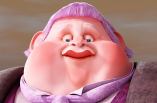

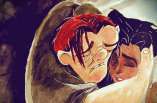








I’ve always loved powerful, low singing voices. This is such an intense song, one of my favourites. Even though as a kid I didn’t really know what the true meaning was.
I think No one got it as a kid and that is why it is so masterfully done. Sonically it is frightening and as a kid you are alerted to the darkness but no sure what it is. Then you re-watch as an adult and it is just stunning on so many levels. Thanks for reading.
Its funny as a kid i got this scence and a young age but i was still at a discomfort. Like you said we were asked to almost feel sorry for him while self reflecting on our own lives
Great article! IMO one of the best portrayals of a realistic and plausable villian in a disney movie.
Frollo’s hate is more so out of self-loathing as a result of cognitive dissonance.
Pretty deep and really neat for a cartoon, then again most produced at this time had some appeal to an adult audience that would most likely be seeing it with thier children
Thanks for the comment. I do think Frollo is the most frightening because of just how realistic he is…and that smile. Pocahontas is also more serious on some levels and I wish the studio wouldn’t shy away from these more intense portrayals.
I agree the scariest villains are never the ones under your bed but the ones that could live next door!
Nice a Disney villain that’s not evil simply to be evil. he is even tormented by his own desire! witch makes the song all that much more powerful.
Thanks for reading!
I rather have my kids watch movies with meaning to them than lie to them with the princess movies. This teaches them that there are people who will hate you and do horrible things just because you are different. Also, Quasimodo didn’t get Esmeralda at the end, they were all happy in the end, but in different ways. It’s just more realistic than the other movies to me. Just my opinion.
I completely agree. I think many parents, I even know some, who refuse to let their children watch this film. I understand it can be an intense viewing experience but it seems dangerous to hide your child away in a bubble. Thanks for reading!
Most relatable Disney Villain. Human temptation and desire vs. religious honor and ones presentation of self among followers and the masses.
I LOVE THAT SONG, it is so powerful. of course when i was younger i did not understand the implications of what he is saying. now that i do, i love the song even more. So powerful and disturbing!
I think I had the same reaction the first time I re-watched it as an adult. I loved it as a kid but of course did not understand everything. Now I consider it in the top 5 Disney songs ever. Also, thanks for reading.
Most of Disney’s villains have been driven by greed or revenge, this is the only time we’ve seen a villain driven by pure lust. That’s dark even for Disney, who routinely kills off characters (albeit mostly villains) in horrendous, violent ways. I mean, even Jafar, who wanted to marry Jasmine, was only in it for the money and power, not for her. And Scar, who was one of the most slimy, sadistic villains Disney has made, was never this twisted. Frollo is scary, because he is not only an evil man, but one who was driven to evil because he tortured himself, and took his deep fear of his emotions and himself out on others, such as Quasimodo and Esmeralda. I mean, what gave Disney the idea to adapt source material with such a dark, sexual undertone? What’s next? Disney Presents “The Scarlet Letter?” Great movie though.
There was a deleted scene from The Lion King of Scar basically trying to seduce Nala, forcing her to be his queen, but they took it out for obvious reasons. So in a way, he kind of was intended to be just as twisted as Frollo is here, they just never showed all his characteristics. Btw, Scar was/is my favorite animated Disney villain. He’s just so damn cool, lol.
Speaking as a person who holds the Lion King as his favorite Disney movie, I find that piece of news fascinating. Now I sort of want to see that deleted scene.
Great analysis of the song “Hellfire” and Frollo more generally. I agree that of all the Disney villains, Frollo is unique in his motivations. He is also one of the more complex villains, as well as the most human.
I know that Frollo was an absolute lunatic, but I still felt somewhat sorry for him in this scene. Mainly because this song’s so darkly beautiful and entrancing (my favourite Disney Villain song by far), but also because he’s tortured by his sexual urges and the torment that he feels is clearly visible in this song. Let’s not forget that lust is one of the seven deadly sins in the Catholic religion. Not only that, but Frollo is sexually attracted to Esmeralda, who’s a gypsy. A woman who belongs to a group of people whom Frollo had been educated to view as nothing more than filth, all his life. His desire for her completely goes against everything that he believes is natural. It still doesn’t excuse the fact that he burnt down all of Paris and threatened to burn her if she didn’t become his sexual plaything, and the fact that he’s still as arrogant and proud and as evil as fuck, but this song probably makes me feel the most mixed emotions of any song that I’ve ever heard before. And this was featured in a kid’s film. That’s worth a round of applause. I’d like to see someone try and sneak something like this – something that’s as daring but as equally full of brilliance – into a child’s film nowadays. Nobody else has the guts to go as far as Disney did when they made this film, and this scene in particular.
Thanks for reading. I agree that when you watch this you struggle with your feelings towards him because in this moment you realize how human he is. The group that worked on this film really pushed the boundaries and it is sad it was a box-office flop by Disney standards.
I used to be so scared to watch the Hunchback of Notre Dame mainly becaus of this song. Now that I’ve grown up, i love it. Its so dark, I mean ” BE MINE OR YOU WILL BURN!” Thats just magic
I watched the Hunchback of NotreDame about a week or two ago (first time watching it) and the lengths that Frollo would go to just to find Esmerelda…including locking a family in their house and setting it on fire.
Disney had some ball’s back then, when it came to story. What happen?
It did not make as much money as the happy brightly colored films made. I would like to see them do stronger stories again and not shy away from intense moments. Thanks for reading!
I’ve noticed that several villains throughout history have been catholic. Rodrigo Borgia was a pope. Nicodemus Morven was a cardinal. Rasputin was a monk. Frollo was a judge (but he was just delusional not pure evil). Wow there are a lot!
This is an excellent analysis and not something I ever would have expected to find an article about. Both on here and in general. Great work =]!
An interesting fact about this song: the Latin chant in the beginning is “mia culpa”, meaning “my fault.” This can allude to that, although Frollo came off as righteous, he was actually consumed by guilt.
This is probably one of the best ever disney songs because of how real it is. It shows a truly VILE villian with a tiny shred of a soul. Disney Villians like Scar were just pure evil, through and through. but in my opinion, Frollo wasn’t evil, he was so twisted and confused. He literally thought what he was doing to the gypsies was, well, right. Hes obviously a religious man torn mentally between his unusual lust for esmerelda, feelings he’s probably never encountered in his life, and what he feels is his duty. and that is a powerful thing to show in a film that’s predominantly aimed at children, fucking bravo disney.
An awesome article on an awesome song~ I’m happy to see it finally published! Great job~~
Thank you so much!
I love how, now that I am older, I understand what this song is about. It’s about a guy who is praying for salvation from the lust he feels for a gypsy- someone who he thinks is below him. And basically, he is saying you either sleep with me, or I will have you burned to death. It’s so messed up… And people think that kids shows NOW are too twisted…
You captured the feel of the song so well. The entire time I read this article, Hellfire was playing not in my ears but in my head. Frollo is a powerfully influential villain and it’s a shame he receives little press when Disney goes to sell. I really like how you pointed to the musical instruments used to make your powerful point, and how you used Freudian analysis to describe his inner emotions and torment. Very good.
The only point I may disagree on is a part near the beginning. “We know what we expect. We do not watch Beauty and the Beast or Pinocchio thinking that the film is going to challenge our belief in “happily ever after”
If any movie challenged my belief in a happily ever after, it was Pinocchio. I don’t recall the mad coachman being punished or the numerous donkey slaves being freed (and don’t get me started on the symbolism in that movie, sexual and otherwise). The only happily ever after was the main character and after that climax, it can feel like too little… and too realistic for Disney standards. Nonetheless, both are fantastic movies and both stand in my top three with the Lion King.
Very good article and five thumbs up!
Thank you so much. I agree that Pinocchio is different than other Disney films as well but I never questioned that the resolution would work out in his favour. That film still freaks me out on many levels. Thanks for reading!
I’ve been revisiting old Disney animated movies upon seeing Maleficent (wasn’t a big fan of the movie but at least something good came out of it). This Hellfire song is the one that left the biggest mark on me, as I had such a vastly different experience hearing it now than back when I was 7 when I first saw it. Really one of the best things Disney has done, villain song or otherwise. Quite enjoyed your analysis.
Thanks so much.
I love that this movie pushed boundaries beyond what was a “typical” Disney movie. And I agree with this analysis, Frollo is a very believable villain and committed evil without anything supernatural as seen in softer Disney movies. Like many others I know, I didn’t understand the magnitude of Hellfire until I was much older. And all of the conflicts are very realistic. What other movies targeted towards children portrays lust, religious hypocrisy, attempted infanticide, and racism in a two-hour timeframe?
A beautifully worded interpretation of my favorite Disney villain song. Great work and I hope to read more from you.
Great article, insightful analysis and beautiful writing! A very original piece indeed, something I ever would have thought to find in an article on Disney! This simply shows us how many implicit meanings and hidden symbols there are in Disney films, and how it is important to pay attention to those details and go deeper in our understanding of those films that have shaped our childhood.
This is definitely one of Disney’s most underrated films!
Good article. This movie is forgotten too often, and this song is so powerful. Good animated movies often deal with real life issues, but its rare to see such adult themes dealt with. And yet they were still able to contain it within a package suitable for kids. I like how far you dug into this song. Thanks for writing!
This article is a hidden gem. One of my favorite songs in the Disney collection. It’s so real and relateable.
I love the song hellfire. still stuck in my head. I love the music cues, especially at the part, ‘I feel her, I see her, The sun caught in her raven hair, is blazing in me out of all control!’ Masterful!